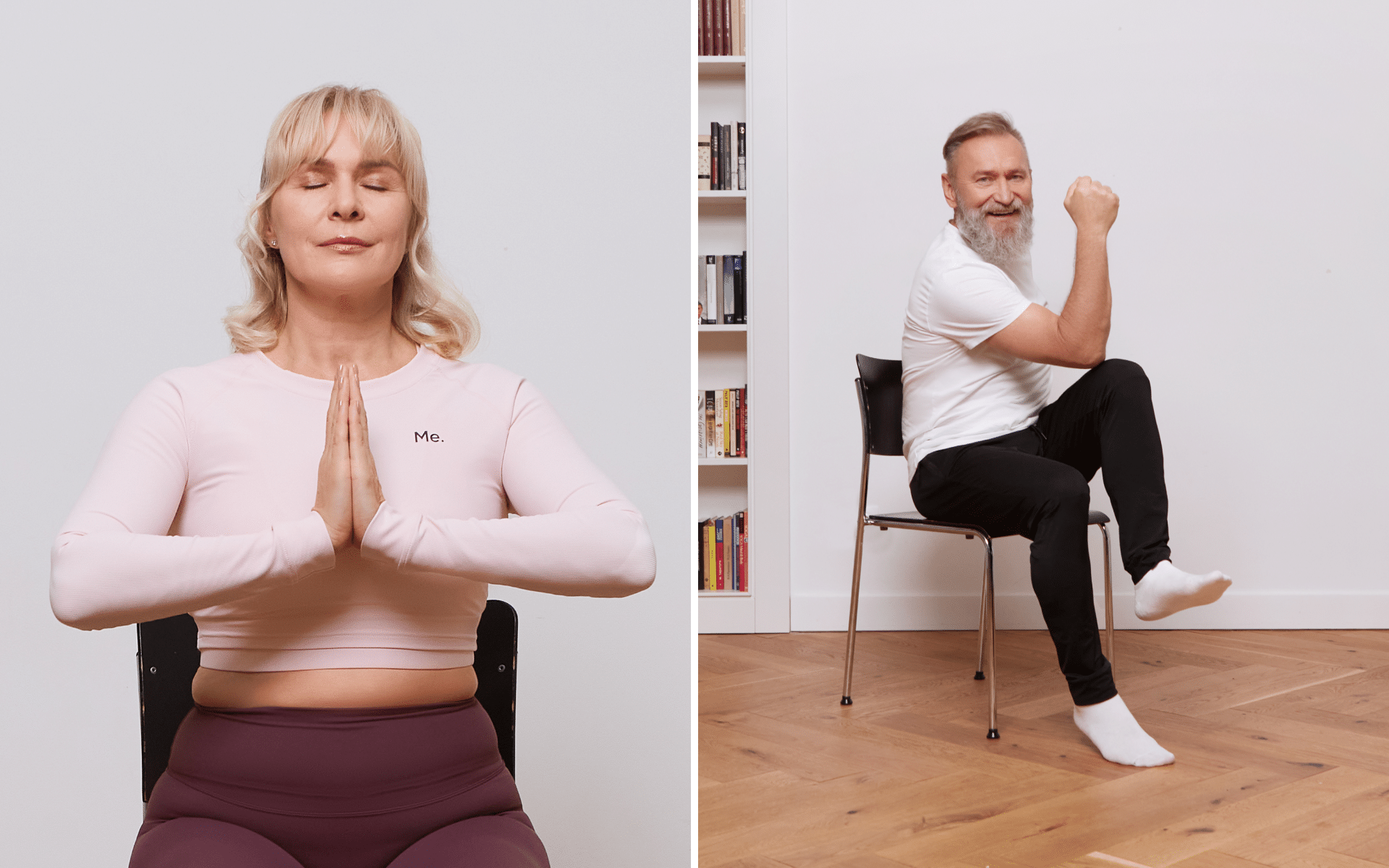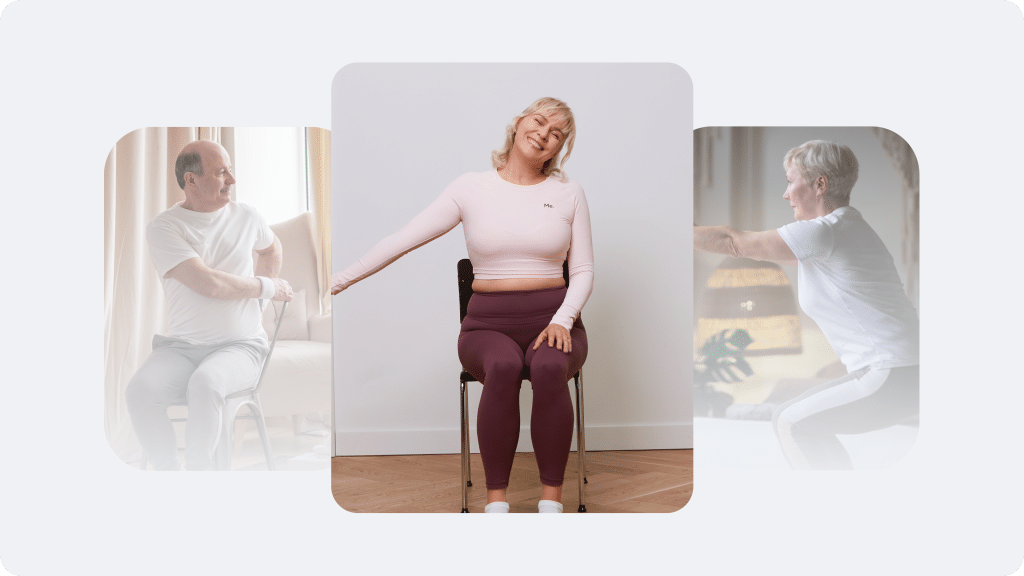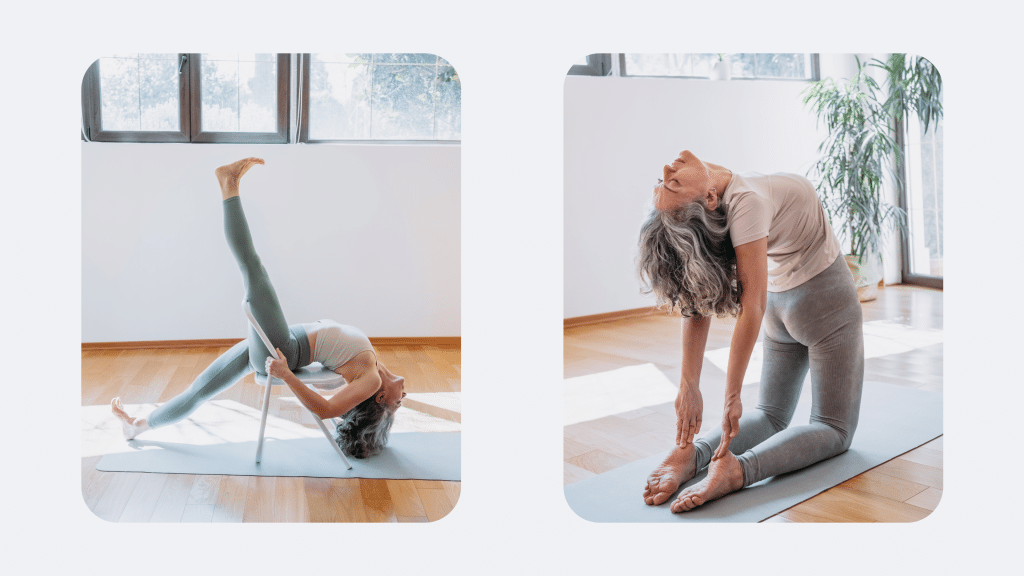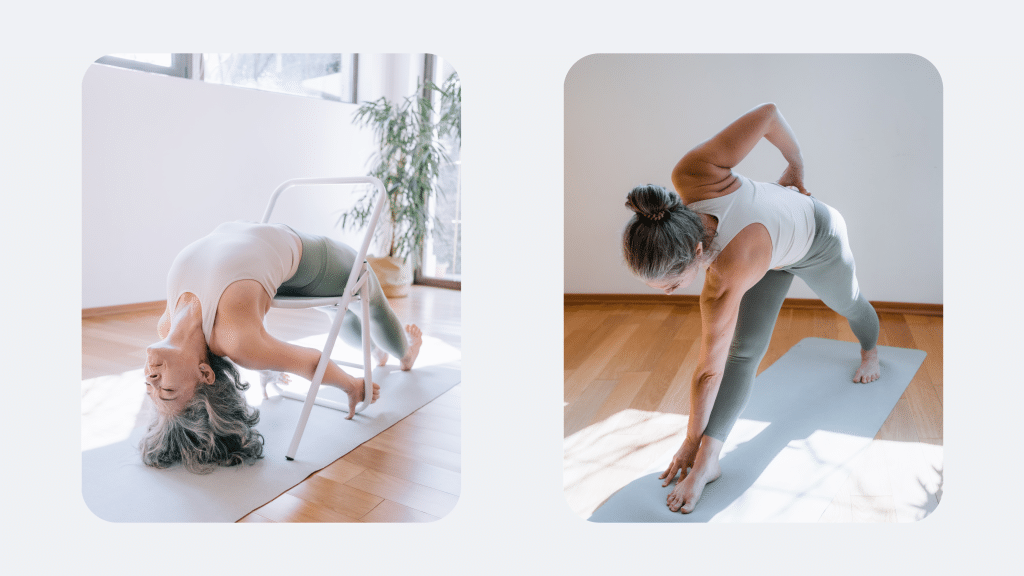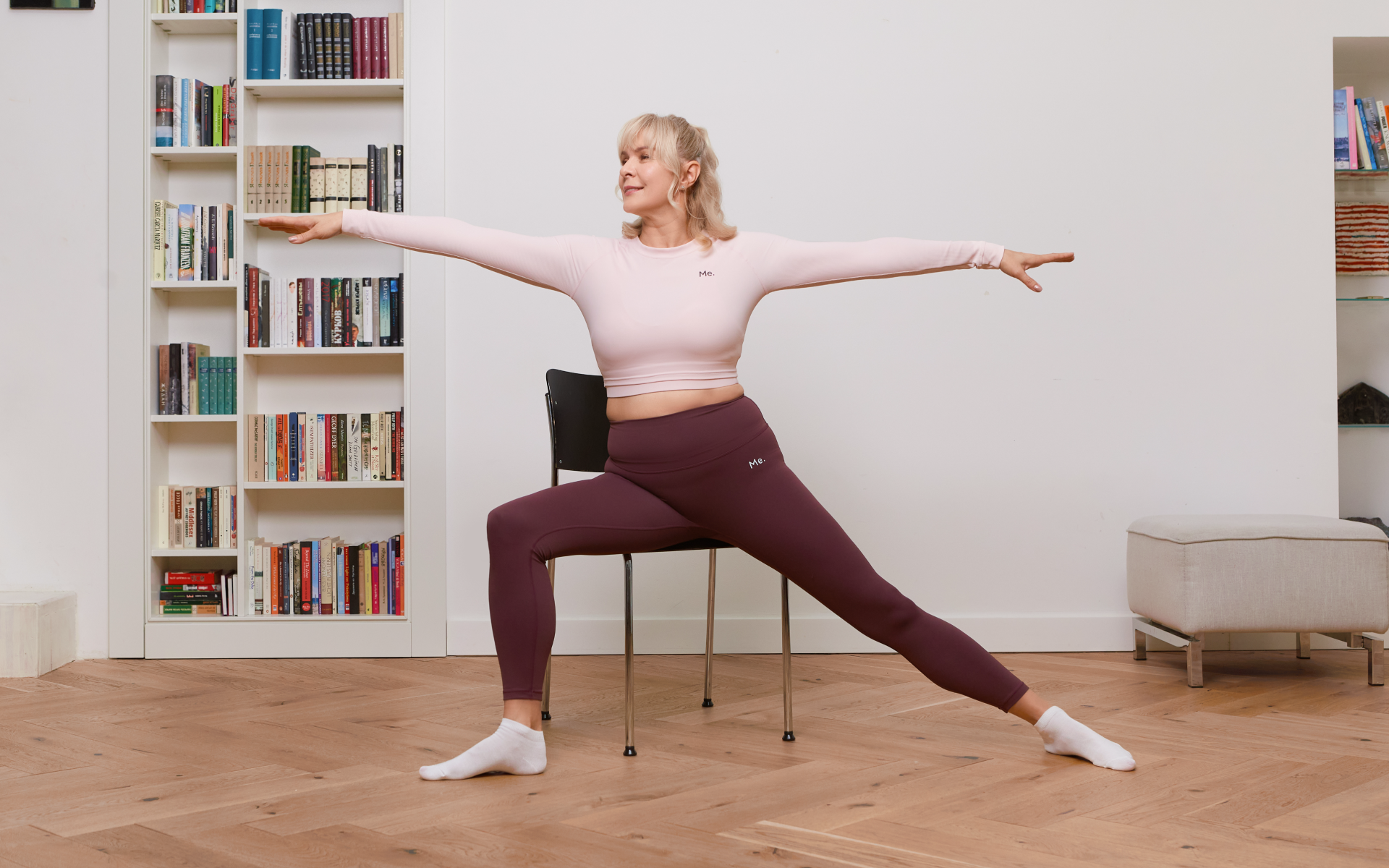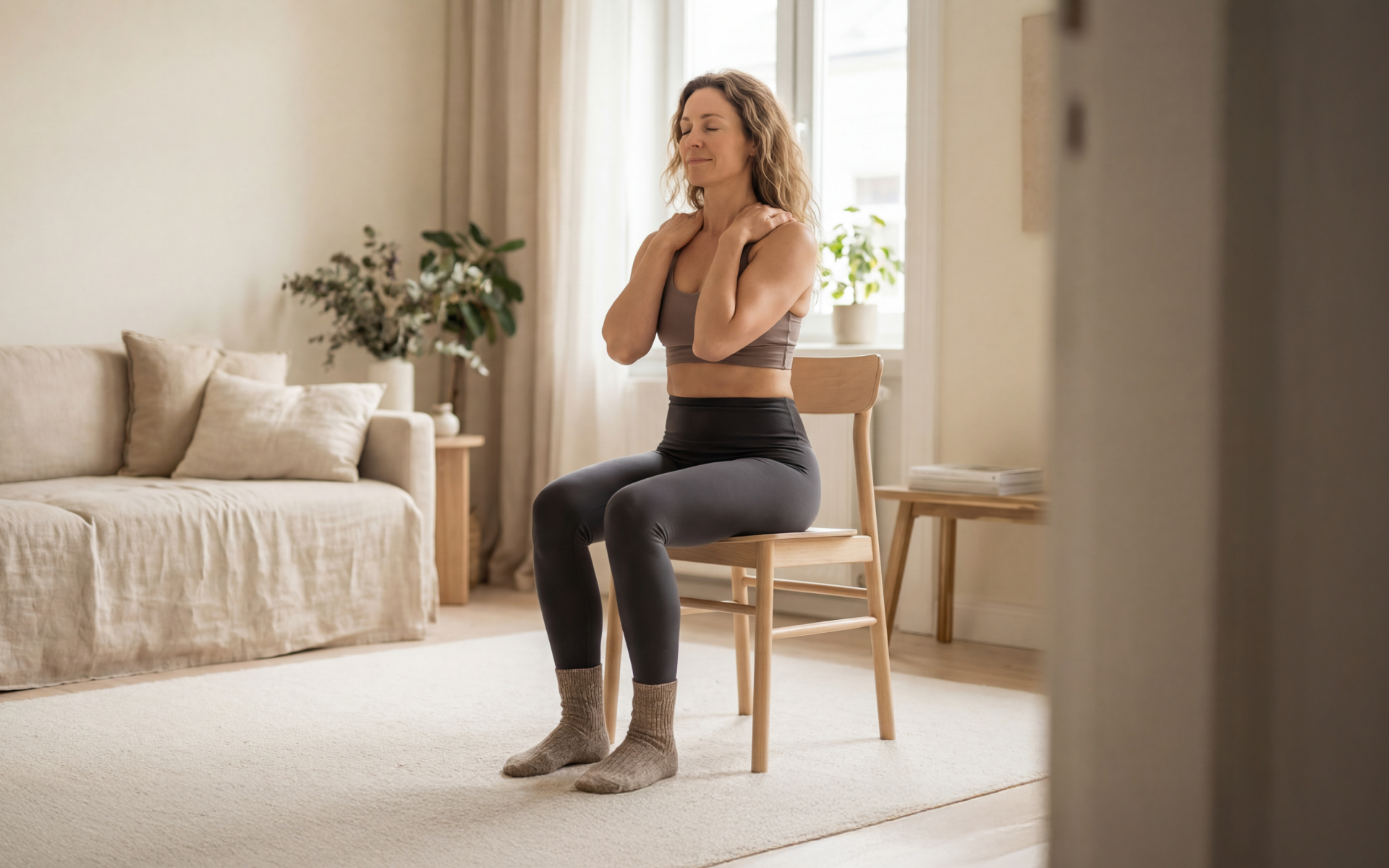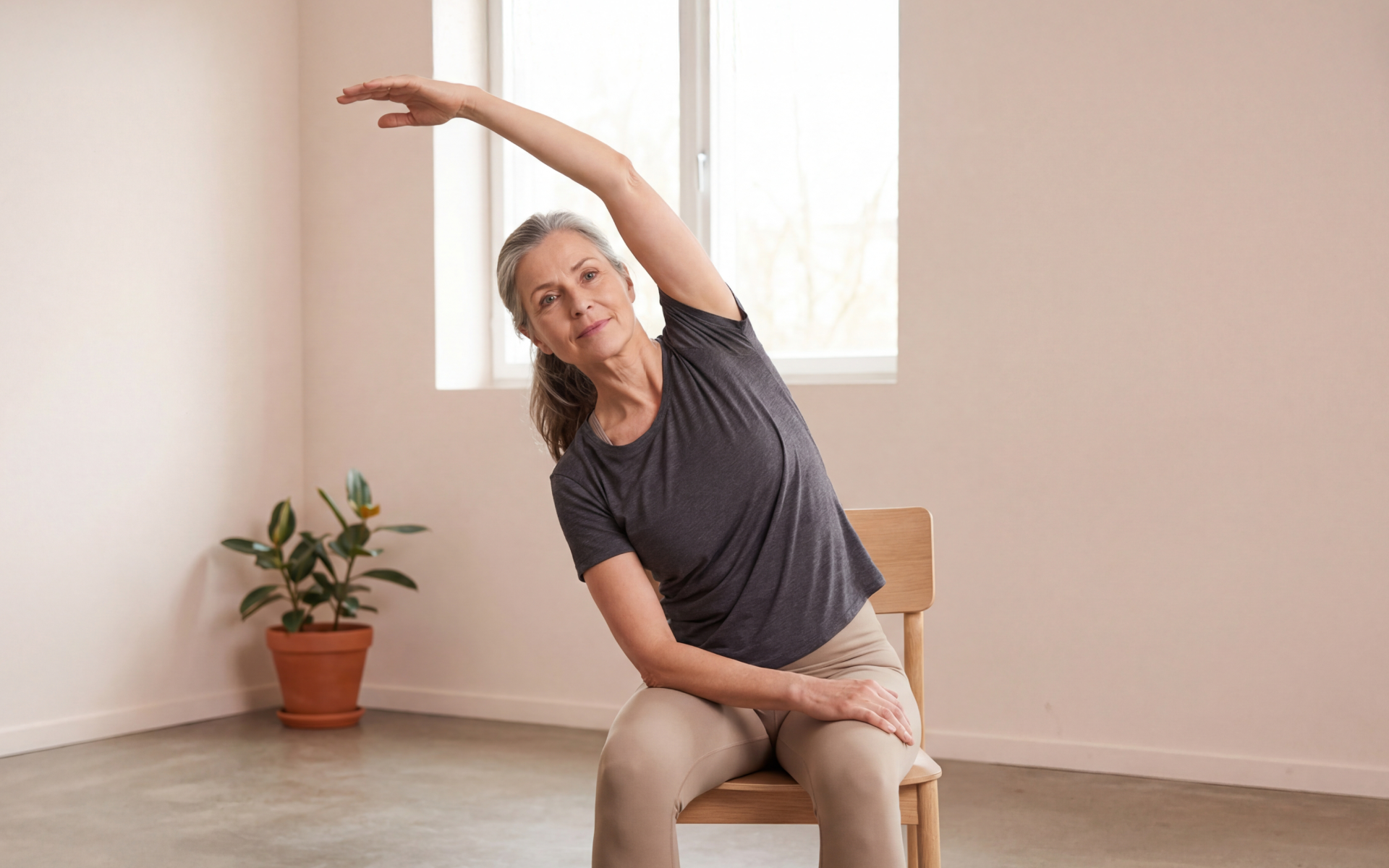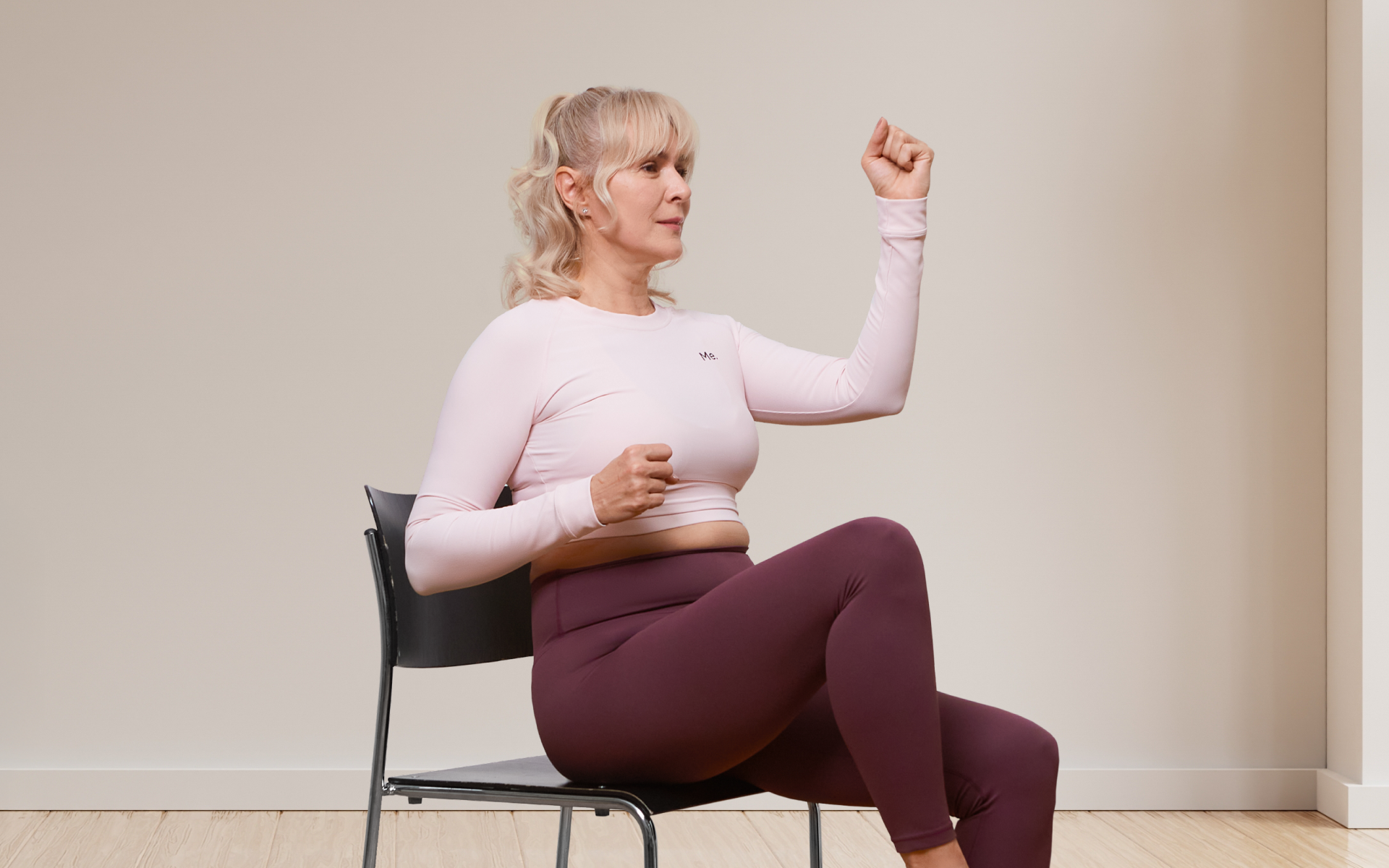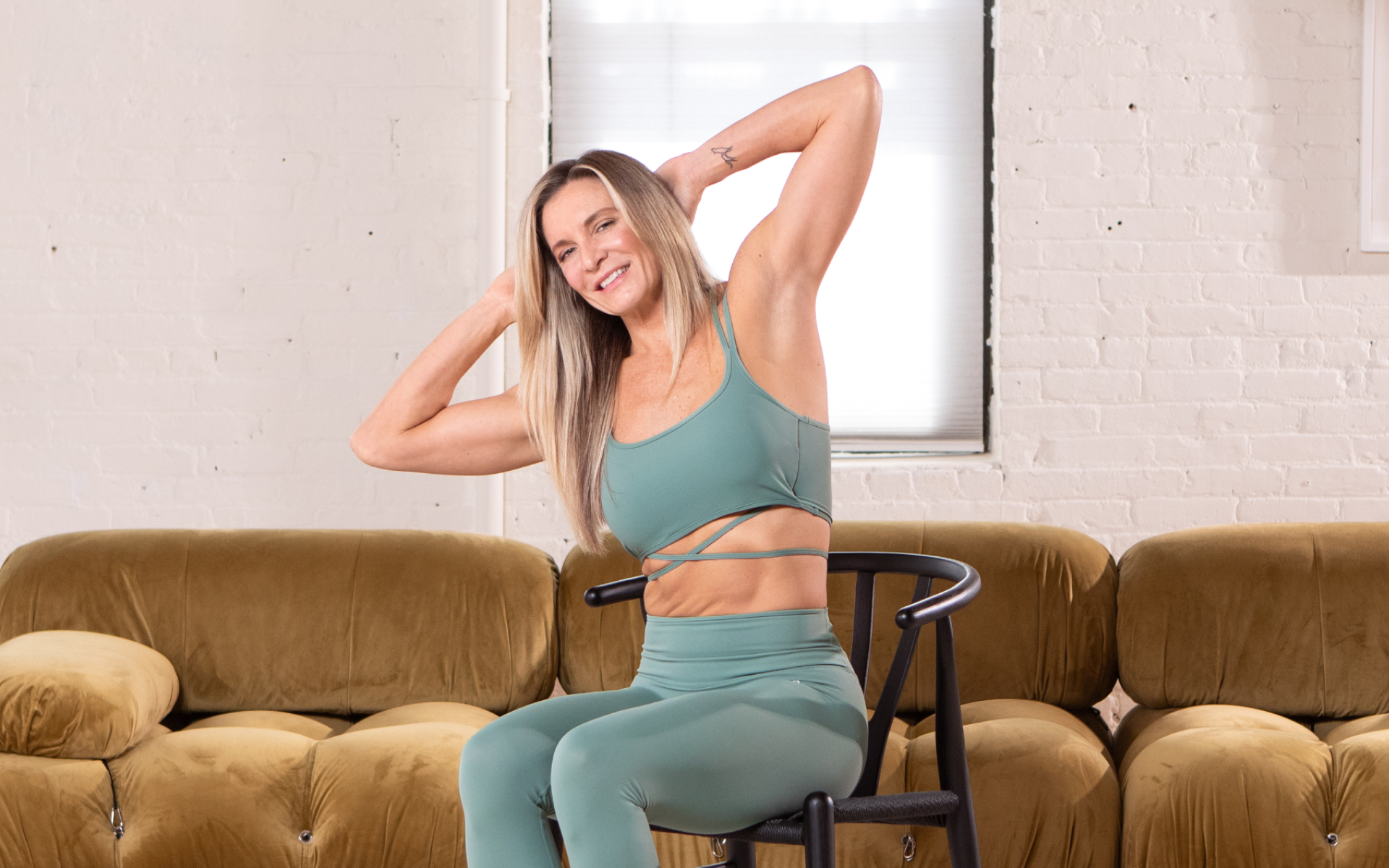The Centers for Disease Control and Prevention (CDC) advises that adults aged 65 years and older should aim for at least 150 minutes of moderate-intensity aerobic activity, such as brisk walking, or 75 minutes of vigorous-intensity aerobic activity, such as running, each week (1).
In addition, they should include muscle-strengthening activities on two or more days a week to maintain muscle mass and strength (1).
Regular physical activity for seniors can reduce the risk of developing dementia, including Alzheimer’s disease, and lower the risk of depression (2). It also supports heart health by reducing the risk of cardiovascular diseases (3).
Despite these benefits, only a small percentage of older Americans engage in the recommended levels of both aerobic and muscle-strengthening activities.
For seniors who may have mobility limitations or prefer to exercise in the comfort of their own homes, chair yoga can be a great option. It provides all the benefits of traditional yoga while being gentle on the joints and accessible for people with various levels of physical ability.
Here are eight chair yoga exercises seniors can incorporate into their daily routines for a full-body workout at home:
What Is the Best Chair Yoga Routine for Seniors?
There’s no one “best” chair yoga routine for seniors as every person’s needs and abilities may vary.
However, effective routines for seniors have some things in common:
- They’re gentle on the body with a focus on proper alignment to prevent strain or injury.
- They incorporate a variety of movements to engage different muscle groups and encourage flexibility.
- They can easily be modified for different levels of ability.
- They include breathing exercises and mindfulness practices for mind-body connection and relaxation.
- They’re enjoyable and can be tailored to individual preferences.
By following these guidelines, seniors can create a chair yoga routine that meets their specific needs and goals.
What Is 28-Day Chair Yoga for Seniors?
28-Day Chair Yoga for Seniors is a program to help seniors incorporate yoga into their daily routines. By setting aside 28 days to focus on a chair yoga practice, seniors can experience the physical and mental benefits of regular exercise.
The program includes a variety of chair yoga exercises that target different muscle groups and promote flexibility, balance, and strength. It also provides guidance on proper alignment and modifications for varying levels of ability.
In addition to the physical aspects, the 28-Day Chair Yoga for Seniors program also incorporates mindfulness practices and breathing exercises to promote relaxation and stress management.
There are many variations of the program available, but all of them aim to provide a comprehensive and customizable chair yoga routine for seniors.
The exercises below can be incorporated into the 28-Day Chair Yoga for Seniors program or used as standalone exercises for a quick and effective workout.
1. Seated Mountain Pose (Tadasana)
This exercise engages the core, shoulders, and back muscles, promoting good postural control. Strengthening these muscles helps improve stability and reduces the risk of falls, which is very important for seniors.
Steps:
- Sit up straight with your feet flat on the floor, hip-width apart.
- Place your hands on your thighs or by your sides.
- Engage your core by pulling your navel toward your spine.
- Inhale deeply, lengthening your spine.
- Roll your shoulders back and down.
- Hold the position for 5-10 breaths, maintaining even breathing.
- Release the tension slowly, relaxing your muscles.
- Repeat 2-3 times for mindfulness and focus.
BetterMe: Health Coaching app helps you achieve your body goals with ease and efficiency by helping to choose proper meal plans and effective workouts. Start using our app and you will see good results in a short time.
2. Seated Cat-Cow Stretch (Marjaryasana-Bitilasana)
Alternating between stretching and contracting the core, back, and neck muscles, this exercise improves spinal flexibility and alleviates tension in the back and neck.
Steps:
- Sit on the chair with your feet flat and your hands on your knees.
- Inhale, arch your back, and look up (cow pose).
- Exhale, round your spine, and tuck your chin (cat pose).
- Continue to alternate movements with each breath.
- Focus on moving with the breath for 5-10 cycles.
- Ensure your movements are gentle and controlled.
- Keep your shoulders relaxed.
- Return to a neutral spine position.
3. Seated Forward Bend (Paschimottanasana)
This exercise targets the hamstrings, lower back, and shoulders, enhancing flexibility and reducing stiffness in the spine and hamstrings.
Steps:
- Sit with your feet flat and your knees together.
- Inhale, lengthen your spine, reaching your arms overhead.
- Exhale, hinge at the hips, and fold forward.
- Let arms gently rest on your shins or ankles.
- Keep your neck relaxed.
- Hold for 5 breaths, deepening the stretch with each exhale.
- Inhale to slowly rise back up.
- Repeat 2-3 times.
4. Seated Side Stretch (Parsva Sukhasana)
Engaging the obliques and shoulders, this stretch improves lateral flexibility and helps maintain a flexible torso, which is essential for daily movements.
Steps:
- Sit upright, your feet flat and spine long.
- Inhale and lift your right arm overhead.
- Exhale and lean to the left, feeling the stretch on the right side.
- Keep your left hand resting on the chair for support.
- Hold for 5 breaths, breathing into your side body.
- Inhale to return to center.
- Repeat on the left side.
- Perform 2-3 rounds on each side.
5. Seated Twist (Ardha Matsyendrasana)
This exercise involves the obliques, core, and back muscles, enhancing spinal flexibility and helping with digestion, which is beneficial for overall health.
Steps:
- Sit with your feet flat and your spine long.
- Inhale and lengthen your spine.
- Exhale and twist to the right, placing your left hand on your right knee.
- Use your right hand for support on the back of the chair.
- Keep your shoulders relaxed and gaze over your right shoulder.
- Hold for 5 breaths.
- Inhale to return to the center.
- Repeat on the left side.
6. Seated Warrior I (Virabhadrasana I)
This pose strengthens the legs, core, and shoulders, improving balance and strength in the lower body, which is important for mobility.
Steps:
- Sit sideways on the chair, your right leg forward and left leg back.
- Inhale and lift your arms overhead, your palms facing each other.
- Press firmly through both feet.
- Hold for 5 breaths, keeping your core engaged.
- Lower your arms and switch sides.
- Repeat 2-3 times on each side.
7. Seated Leg Lifts
Targeting the quadriceps and hip flexors, this exercise strengthens the legs and helps with mobility and balance, which is essential for daily activities.
Steps:
- Sit with your feet flat on the floor, your hands on the chair sides.
- Inhale and lift your right leg, extending it straight.
- Hold for 2-3 seconds, then lower.
- Repeat with your left leg.
- Perform 10 lifts on each side.
- Maintain an upright posture throughout.
- Focus on controlled movements.
- Engage your core muscles for stability.
8. Seated Sun Salutation (Surya Namaskar)
Engaging the entire body, including arms, shoulders, core, and legs, this sequence increases overall body awareness and flexibility.
Steps:
- Begin in seated mountain pose.
- Inhale and reach your arms overhead.
- Exhale and fold forward into seated forward bend.
- Inhale and rise back up, your arms overhead.
- Exhale and lower your arms to your sides.
- Repeat 5-10 times, coordinating with your breath.
- Move smoothly between poses.
- Focus on breath and movement synchronization.
9. Seated Eagle Pose (Garudasana)
Focusing on the shoulders, upper back, and hips, this pose enhances joint mobility and reduces tension, which can alleviate discomfort.
Steps:
- Sit tall with your feet flat.
- Cross your right arm over your left, bending your elbows.
- Wrap your forearms, trying to bring your palms together.
- Lift your elbows to shoulder height.
- Hold for 3-5 breaths.
- Unwind and repeat your left arm over your right.
- Optionally, cross your legs similarly to engage your hips.
- Repeat 2-3 times on each side.
10. Seated Relaxation (Savasana)
This exercise promotes relaxation and mental clarity, reducing stress and enhancing overall well-being.
Steps:
- Sit comfortably, with your feet flat and your hands resting on your lap.
- Close your eyes and take deep, calming breaths.
- Allow your body to relax fully.
- Focus on your breathing, inhaling and exhaling slowly.
- Stay in this position for 5-10 minutes.
- Gradually bring awareness back to the room.
- Open your eyes slowly, stretching gently.
- End the practice with gratitude.
Read more: Can You Lose Weight Doing Chair Yoga? The Effects Of This Gentle Exercise On Weight
How Many Times a Week Should Seniors Do Chair Yoga?
Seniors are encouraged to engage in chair yoga at least 2-3 times a week. This frequency allows for consistent practice that can enhance flexibility, balance, and overall well-being without causing strain or fatigue.
The Centers for Disease Control and Prevention (CDC) suggests that older adults should aim for at least 150 minutes of moderate-intensity aerobic activity per week, which can include chair yoga as a part of a balanced exercise regimen (1).
Yoga experts often recommend starting with shorter sessions, approximately 20-30 minutes each, and gradually increasing the duration as your comfort and capability grow.
Factors such as individual health conditions, fitness levels, and personal goals should be considered when determining the ideal frequency of chair yoga practice.
For example, seniors with chronic health issues or mobility limitations may benefit from more frequent, shorter sessions to build strength and confidence at a comfortable pace.
Conversely, those with higher fitness levels may engage in longer sessions or incorporate additional exercises to complement their chair yoga practice.
Does Chair Yoga for Seniors Really Work?
Chair yoga has been shown to provide numerous physical and mental benefits for seniors:
- Flexibility and Balance
Research has indicated that regular yoga practice can significantly improve flexibility and balance (4), which are essential for preventing falls—a major concern for seniors (5). By engaging in gentle stretches and controlled movements, seniors can enhance their joint mobility and maintain stability.
- Muscular Strength and Endurance
Chair yoga helps build muscle strength (6) without the risk associated with high-impact exercises.
Studies have shown that even low-intensity strength training, including exercises done in chair yoga, can enhance muscle definition, particularly in the core and legs, contributing to better physical support and endurance (7).
- Mental Well-being
The mindfulness component of yoga helps alleviate stress and anxiety, promoting a sense of calm and mental clarity. For seniors, this can lead to improved mood and cognitive function, as supported by numerous studies that have linked yoga to enhanced mental health (8).
Reasons why BetterMe is a safe bet: a wide range of calorie-blasting workouts, finger-licking recipes, 24/7 support, challenges that’ll keep you on your best game, and that just scratches the surface! Start using our app and watch the magic happen.
- Independence and Quality of Life
By improving physical strength, balance, and flexibility, chair yoga can help seniors maintain their independence and enhance their overall quality of life (9).
It also provides a sense of accomplishment and empowerment that can boost self-confidence and motivation to engage in other activities.
Learn how seated workouts can help relieve pain and improve overall quality of life in our previous article, Chair Exercises For Lower Back Pain.
Read more: Chair Pose Yoga Benefits and Hacks You’ve Never Tried
Can You Lose Weight Doing Chair Yoga for Seniors?
Chair yoga isn’t typically considered a weight loss exercise, but it can contribute to gradual weight loss and maintenance in seniors.
Through its focus on gentle movements, controlled breathing, and mindfulness, chair yoga helps reduce stress and improve overall well-being, which can play a role in managing emotional eating habits that may lead to weight gain (10).
In addition, some poses in chair yoga require engaging multiple muscle groups simultaneously, which contributes to calorie burning and muscle toning. However, the extent of these effects may vary based on factors such as individual fitness levels and session duration.
Ultimately, incorporating chair yoga as part of a balanced exercise routine that includes aerobic activity and healthy eating habits can support the weight management efforts of seniors.
It may be okay for seniors to practice chair yoga every day, depending on their overall physical condition and exercise goals. Daily practice can promote consistency, which is beneficial for improving flexibility, balance, and mental well-being. However, it’s important to pay attention to your body’s signals and ensure you don’t overexert yourself. If you have specific health conditions, it’s wise to consult a healthcare professional before you start a daily routine to make any necessary modifications. If you experience chronic pain, check out our Chair Pilates for Seniors guide and learn how exercises can help manage chronic pain. Chair yoga is designed to be accessible and gentle, which makes it suitable for seniors and those with limited mobility. The exercises are typically low-impact and can be modified to accommodate individual abilities and health conditions (11). Most participants find chair yoga manageable, and it can be adjusted to suit varying levels of fitness and flexibility, ensuring a non-intimidating workout. The best chair yoga for seniors is one that aligns with their individual needs, abilities, and health considerations. Chair yoga programs that focus on enhancing flexibility, strength, and balance while offering modifications for varying skill levels are ideal. It’s beneficial to choose classes led by certified instructors who have experience working with seniors, as they can provide appropriate guidance and support. Learn about the pros and cons of Wall Exercises For Seniors in our earlier post. The number of calories burned during chair yoga for seniors can vary based on factors such as the intensity and duration of the session, in addition to an individual’s weight and metabolic rate. On average, a chair yoga session burns between 100 and 150 calories per hour for most seniors. While calorie burn is a consideration, the primary focus of chair yoga is often on improving flexibility, balance, and mental relaxation rather than intense calorie expenditure.Frequently Asked Questions
Is it OK to do chair yoga every day?
Is chair yoga difficult?
Which is the best chair yoga for seniors?
How many calories do you burn in chair yoga for seniors?
The Bottom Line
Chair yoga is an effective form of exercise for seniors that provides numerous physical and mental benefits. With its focus on gentle movements and mindfulness, it’s accessible to seniors with varying fitness levels and health conditions.
By incorporating chair yoga into their routine 2-3 times a week, seniors can enhance their flexibility, balance, strength, and overall well-being, which can lead to a more fulfilling and independent lifestyle.
It’s important to consult a healthcare provider before starting any new exercise regimen and listen to your body’s signals during practice to avoid injury or overtraining.
DISCLAIMER:
This article is intended for general informational purposes only and does not serve to address individual circumstances. It is not a substitute for professional advice or help and should not be relied on for making any kind of decision-making. Any action taken as a direct or indirect result of the information in this article is entirely at your own risk and is your sole responsibility.
BetterMe, its content staff, and its medical advisors accept no responsibility for inaccuracies, errors, misstatements, inconsistencies, or omissions and specifically disclaim any liability, loss or risk, personal, professional or otherwise, which may be incurred as a consequence, directly or indirectly, of the use and/or application of any content.
You should always seek the advice of your physician or other qualified health provider with any questions you may have regarding a medical condition or your specific situation. Never disregard professional medical advice or delay seeking it because of BetterMe content. If you suspect or think you may have a medical emergency, call your doctor.
SOURCES:
- Older Adult Activity: An Overview | Physical Activity Basics (2023, cdc.gov)
- Physical Activity: A Viable Way to Reduce the Risks of Mild Cognitive Impairment, Alzheimer’s Disease, and Vascular Dementia in Older Adults (3017, ncbi.nlm.nih.gov)
- Cardiovascular Risk Factors and Physical Activity for the Prevention of Cardiovascular Diseases in the Elderly (2021, ncbi.nlm.nih.gov)
- Effects of yoga on flexibility and balance: a quasi-experimental study (2017, researchgate.net)
- Physical activity programs for balance and fall prevention in elderly (2019, ncbi.nlm.nih.gov)
- Meta-Analysis of the Effect of Yoga Practice on Physical Fitness in the Elderly (2021, ncbi.nlm.nih.gov)
- Adaptations to Endurance and Strength Training (2018, ncbi.nlm.nih.gov)
- Yoga for better mental health – Harvard Health (2024, health.harvard.edu)
- The Effectiveness of Chair Yoga in Older Adults: A Literature Review (2023, researchgate.net)
- Exploring the therapeutic effects of yoga and its ability to increase quality of life (2011, ncbi.nlm.nih.gov)
- How to Do Chair Yoga (2024, webmd.com)
